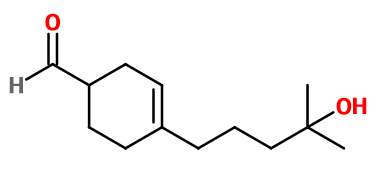Lyral®
Synthétique
Floral > Light Flowers > Aldehydic > Fresh Flowers > Aquatic

Crédits photo: ScenTree SAS
Other names :
Kovanol® ; Leerall® ; 4-(4-hydroxy-4-methylpentyl)cyclohex-3-ene-1-carbaldehyde ; Cyclohexal ; 4-(4-hydroxy-4-methylpentyl)-3-cyclohexene-1-carboxaldehyde ; Kovyral ; Landolal ; Lanyral ; Lydoucal ; Lysinal ; Mugonal
Volatility :
Heart
Uses in perfumery :
Lyral® is used in floral notes such as white flowers, lily of the valley, lilac or lily.
Natural availability :
Lyral® is not available in its natural state.
Year of discovery :
Discovered in 1958.
Patent N°868,850 published on May 8, 1958 by IFF
Other comments :
Lyral® was subject to a recall procedure in 2019, and its use will be banned in 2021.
It is one of the 26 allergens in perfumery.
It is one of the 26 allergens in perfumery.
Price Range :
€€
Stability :
Aldehydes may form diethylacetals in alcoholic perfumes, with no real impact on their smell.

Crédits photo: ScenTree SAS
- Molecular formula :
- C13H22O2
- Molecular Weight :
- 210,32 g/mol
- Density :
- 0,995
- Flash Point :
- 105°C
- Fusion Point :
- -20°C
- Appearance :
- Colorless liquid that crystallizes at room temperature
- Log P :
- 2,08
- Boiling Point :
- 121°C
- Detection Threshold :
- 0,1 ng/L air
Synthesis route :
Lyral® is synthesized by a Diels-Alder reaction between Myrcenol and Acrolein (or Propenal) in the presence of a Lewis catalyst such as zinc chloride. When this reaction is performed without a catalyst and at a high temperature, it results in the formation of a mixture of two positional isomers of Lyral®, although Lyral® is still predominant (70%).
Synthesis precursor :
Lyral® forms Schiff bases in the presence of amino compounds such as Methyl Anthranilate or Indole.
Isomerism :
The positional isomer that is formed during the synthesis of Lyral® has no great olfactory difference with Lyral® used in perfumery. Geranyl Propionate is a constitutional isomer of Lyral®. Their smell is very different as Geranyl Propionate is much rosier.
- EINECS number :
- 250-863-4
- FEMA number :
- Donnée indisponible.
- JECFA number :
- Donnée indisponible.
- FLAVIS number :
- Donnée indisponible.
- Allergens :
- Lyral® may provoke an allergic reaction on skin contact (redness, heat, scraching, prickling) for some people.
- IFRA :
- This ingredient is restricted by IFRA
- Restriction type :
- RESTRICTION
- Cause of restriction :
- DERMAL SENSITIZATION AND SYSTEMIC TOXICITY
- Amendment :
- 49
- Comments :
- The restrictions as given for the individual categories are not based on the Quantitative Risk Assessment (QRA) methodology but solely represent a pragmatic approach to address the specific situation for 3 and 4-(4-Hydroxy-4-methylpentyl)-3-cyclohexene-1-carboxaldehyde (HMPCC). This ingredient is part of the Schiff base (Lyral-methyl anthranilate (or Lyrantion) - N°CAS :67634-12-2) and induces the application of IFRA regulations for 61,3% of the Schiff base usage. Please also refer to the IFRA Annex II for more information
- Quantitative limit on the use :
-
Cat.1 Cat.2 Cat.3 Cat.4 Cat.5A Cat.5B Cat.5C Cat.5D Cat.6 0,02 % 0,02 % 0,1 % 0,2 % 0,2 % 0,2 % 0,2 % 0,067 % 0,2 % Cat.7A Cat.7B Cat.8 Cat.9 Cat.10A Cat.10B Cat.11A Cat.11B Cat.12 0,02 % 0,02 % 0,067 % 0,2 % 0,2 % 0,2 % 0,067 % 0,067 % 91 % - Restriction type :
- RESTRICTION
- Cause of restriction :
- DERMAL SENSITIZATION AND SYSTEMIC TOXICITY
- Amendment :
- 49
- Comments :
- When used in the same fragrance compound within a specific QRA category, the sum total of Methyl heptine carbonate (MHC, CAS number 111-12-6) and Methyl octine carbonate (MOC, CAS number 111-80-8) contributions must not exceed the maximum permitted level for MHC. At the same time, the contribution from MOC should always respect the maximum levels permitted in the respective categories as listed in the Standard for MOC.
- Quantitative usage limits :
-
Cat.1 Cat.2 Cat.3 Cat.4 Cat.5 Cat.6 Cat.7 Cat.8 Cat.9 Cat.10 Cat.11 0,02 % 0,02 % 0,1 % 0,2 % 0,2 % 0,2 % 0,02 % 0,067 % 0,2 % 0,2 % 0,067 %
To learn more about IFRA's standards : https://ifrafragrance.org/safe-use/library
ScenTree is solely responsible for the information provided here.

